Page 6 of 443
Table of Contents
HEV Overview
Illustrated table of contents
Safety—Seats, seat belts and supplemental restraint system
Instruments and controls
Pre-driving checks and adjustments
Monitor, climate, audio, phone and voice recognition systems
Starting and driving
In case of emergency
Appearance and care
Maintenance and do-it-yourself
Technical and consumer information
Index
HEV
0
1
2
3
4
5
6
7
8
9
10
Page 21 of 443
1. Supplemental front-impact air bags(P. 1-46)
2. Occupant classification sensor
(weight sensor) (P. 1-46)
3. Head restraints/headrests (P. 1-9)
4. Front seat belts with pretensioner(s)
and shoulder height adjuster
(P. 1-13, 1-46)
5. Roof-mounted curtain side-impact and
rollover supplemental air bag (P. 1-46)
6. Rear seat center seat belt (located on
ceiling) (P. 1-13)
7. Rear seat outboard seat top tether
strap anchor (located on bottom of
seatback) (P. 1-26)
8. LATCH (Lower Anchors and Tethers for
CHildren) system (P. 1-26)
9. Folding rear bench seat (P. 1-2)
10. Front seat-mounted side-impact
supplemental air bag (P. 1-46)
11. Front seats (P. 1-2)
12. Driver supplemental knee air bag
(P. 1-46)
Refer to the page number indicated in pa-
rentheses for operating details.
LII2370
AIR BAGS, SEAT BELTS AND CHILD
RESTRAINTS
0-2Illustrated table of contents
Page 26 of 443
14. Heater and air conditioning controls(P. 4-19)
15. Shift lever (P. 5-16)
16. Push-button ignition switch (P. 5-11)
17. Cruise control main switches
(if so equipped) (P. 5-40)
Intelligent Cruise Control (ICC)
switches (if so equipped) (P. 5-42
18. Driver supplemental knee air bag
(P. 1-46)
19. Bluetooth® Hands-Free Phone System
(P. 4-24)
Audio control switches*
20. Hood release (P. 3-20) Fuel door release (P. 3-26)
Power rear flip-up seats switch
(if so equipped) (P. 1-2)
21. Fuse box (P. 8-23)
22. Liftgate opener switch (if so equipped)
(P. 3-21)
Heated steering wheel switch
(if so equipped) (P. 2-45)
Vehicle Dynamic Control (VDC) OFF
switch (P. 2-46)
ECO mode switch (P. 5-16) 23. Instrument brightness control (P. 2-37)
Twin trip odometer reset switch
(P. 3-29)
*: Refer to the separate Navigation System Own-
er’s Manual.
Refer to the page number indicated in pa-
rentheses for operating details.
Illustrated table of contents0-7
Page 30 of 443

1 Safety—Seats, seat belts and
supplemental restraint system
Seats............................................1-2
Front power seat adjustment .....................1-3
Rear bench seat adjustment .....................1-5
Armrests ......................................1-6
Flexible seating .................................1-6
Head restraints/headrests ..........................1-9
Adjustable head restraint/headrest
components .................................. 1-10
Non-adjustable head restraint/headrest
components .................................. 1-10
Remove ...................................... 1-10
Install ........................................ 1-11
Adjust ........................................ 1-11
Seat belts ....................................... 1-13
Precautions on seat belt usage ..................1-13
Seat belt warning light ......................... 1-16
Pregnant women .............................. 1-16
Injured persons ................................ 1-16
Three-point type seat belt with retractor ..........1-16
Seat belt extenders ............................ 1-22
Seat belt maintenance ......................... 1-23Child safety
...................................... 1-23
Infants ........................................ 1-24
Small children ................................. 1-24
Larger children ................................ 1-24
Child restraints ................................... 1-26
Precautions on child restraints ..................1-26
LATCH (Lower Anchors and Tethers for
CHildren) system .............................. 1-28
Rear-facing child restraint installation using
LATCH....................................... 1-31
Rear-facing child restraint installation using
the seat belts ................................. 1-33
Forward-facing child restraint installation
using LATCH .................................. 1-35
Forward-facing child restraint installation
using the seat belts ............................ 1-39
Booster seats ................................. 1-43
Supplemental Restraint System (SRS) ..............1-46
Precautions on SRS ........................... 1-46
Supplemental air bag warning labels .............1-66
Supplemental airbag
warning light .............. 1-66
Page 31 of 443

WARNING
●Do not ride in a moving vehicle when
the seatback is reclined. This can be
dangerous. The shoulder belt will not
be against your body. In an accident,
you could be thrown into it and receive
neck or other serious injuries. You
could also slide under the lap belt and
receive serious internal injuries. ●
For the most effective protection when
the vehicle is in motion, the seat should
be upright. Always sit well back and
upright in the seat with both feet on the
floor and adjust the seat properly. For
additional information, refer to “Pre-
cautions on seat belt usage” in this
section.
● After adjustment, gently rock in the seat
to make sure it is securely locked. ●
Do not leave children unattended inside
the vehicle. They could unknowingly ac-
tivate switches or controls. Unattended
children could become involved in seri-
ous accidents.
● To help avoid risk of injury or death
through unintended operation of the
vehicle and/or its systems, do not leave
children, people who require the assis-
tance of others or pets unattended in
your vehicle. Additionally, the tempera-
ture inside a closed vehicle on a warm
day can quickly become high enough to
cause a significant risk of injury or
death to people and pets.
● Do not adjust the driver’s seat while
driving so full attention may be given to
vehicle operation. The seat may move
suddenly and could cause loss of con-
trol of the vehicle.
● The seatback should not be reclined
any more than needed for comfort. Seat
belts are most effective when the pas-
senger sits well back and straight up in
the seat. If the seatback is reclined, the
risk of sliding under the lap belt and
being injured is increased.
ARS1152
SEATS
1-2Safety—Seats, seat belts and supplemental restraint system
Page 32 of 443

CAUTION
When adjusting the seat positions, be
sure not to contact any moving parts to
avoid possible injuries and/or damage.
FRONT POWER SEAT ADJUSTMENT
Operating tips
●The power seat motor has an auto-reset
overload protection circuit. If the motor
stops during operation, wait 30 seconds,
then reactivate the switch.
● Do not operate the power seat switch for a
long period of time when the Hybrid System
is not in the READY mode. This will dis-
charge the vehicle battery.
For additional information about automatic driver
positioner operation, refer to “Automatic drive positioner” in “Pre-driving checks and adjust-
ments” section of this manual.Forward and backward
Moving the switch forward or backward will slide
the seat forward or backward to the desired
position.
Reclining
Move the recline switch backward until the de-
sired angle is obtained. To bring the seatback
forward again, move the switch forward and
move your body forward. The seatback will move
forward.
LRS2662
Safety—Seats, seat belts and supplemental restraint system1-3
Page 33 of 443
The reclining feature allows adjustment of the
seatback for occupants of different sizes for
added comfort and to help obtain proper seat
belt fit. For additional information, refer to “Pre-
cautions on seat belt usage” in this section. Also,
the seatback can be reclined to allow occupants
to rest when the vehicle is stopped and the shift
lever is in P (Park) .
Seat lifter (driver’s seat)
Push the front or rear end of the switch up or
down to adjust the angle and height of the seat
cushion.
Lumbar support (driver’s seat)
The lumbar support feature provides adjustable
lower back support to the driver. Push the front or
back end of the switch to adjust the seat lumbar
area.
LRS2636LRS2270
1-4Safety—Seats, seat belts and supplemental restraint system
Page 34 of 443

REAR BENCH SEAT ADJUSTMENTReclining
Pull the reclining strap�Aand position the seat-
back at the desired angle. Release the reclining
strap after positioning the seat at the desired
angle.
The reclining feature allows adjustment of the
seatback for occupants of different sizes to help
obtain proper seat belt fit. For additional informa-
tion, refer to “Precautions on the seat belt usage”
in this section. The seatback may also be reclined
to allow occupants to rest when the vehicle is
parked.
WARNING
● After adjustment, check to be sure the
seat is securely locked.
● Do not ride in a moving vehicle when
the seatback is reclined. This can be
dangerous. The shoulder belt will not
be against your body. In an accident,
you could be thrown into it and receive
neck or other serious injuries. You
could also slide under the lap belt and
receive serious internal injuries.
● For the most effective protection when
the vehicle is in motion, the seat should
be upright. Always sit well back and
upright in the seat with both feet on the
floor and adjust the seat belt properly.
For additional information, refer to
“Precautions on seat belt usage” in this
section.
LRS2570LRS2635
Safety—Seats, seat belts and supplemental restraint system1-5